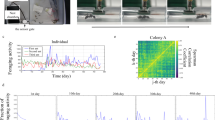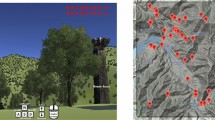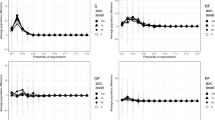Abstract
We address the general question of what is the best statistical strategy to adapt in order to search efficiently for randomly located objects (‘target sites’). It is often assumed in foraging theory that the flight lengths of a forager have a characteristic scale: from this assumption gaussian, Rayleigh and other classical distributions with well-defined variances have arisen. However, such theories cannot explain the long-tailed power-law distributions1,2 of flight lengths or flight times3,4,5,6 that are observed experimentally. Here we study how the search efficiency depends on the probability distribution of flight lengths taken by a forager that can detect target sites only in its limited vicinity. We show that, when the target sites are sparse and can be visited any number of times, an inverse square power-law distribution of flight lengths, corresponding to Lévy flight motion, is an optimal strategy. We test the theory by analysing experimental foraging data on selected insect, mammal and bird species, and find that they are consistent with the predicted inverse square power-law distributions.
This is a preview of subscription content, access via your institution
Access options
Subscribe to this journal
Receive 51 print issues and online access
$199.00 per year
only $3.90 per issue
Buy this article
- Purchase on Springer Link
- Instant access to full article PDF
Prices may be subject to local taxes which are calculated during checkout



Similar content being viewed by others
References
Tsallis,C. Lévy distributions. Phys. World 10, 42–45 (1997).
Schlesinger,M. F., Zaslavsky,G. M. & Frisch,U. (eds) Lévy Flights and Related Topics in Physics (Springer, Berlin, 1995).
Levandowsky,M., Klafter,J. & White,B. S. Swimming behavior and chemosensory responses in the protistan microzooplankton as a function of the hydrodynamic regime. Bull. Mar. Sci. 43, 758–763 (1988).
Schuster,F. L. & Levandowsky,M. Chemosensory responses of Acanthamoeba castellani: Visual analysis of random movement and responses to chemical signals. J. Eukaryotic Microbiol. 43, 150–158 (1996).
Cole,B. J. Fractal time in animal behaviour: The movement activity of Drosophila. Anim. Behav. 50, 1317–1324 (1995).
Viswanathan,G. M. et al. Lévy flight search patterns of wandering albatrosses. Nature 381, 413–415 (1996).
Shlesinger,M. F. & Klafter,J. in On Growth and Form (eds Stanley, H. E. & Ostrowsky, N.) 279–283 (Nijhoff, Dordrecht, 1986).
Berkolaiko,G., Havlin,S., Larralde,H. & Weiss,G. H. Expected number of distinct sites visited by N discrete Lévy flights on a one-dimensional lattice. Phys. Rev. E 53, 5774–5778 (1996).
Berkolaiko,G. & Havlin,S. Territory covered by N Lévy flights on d-dimensional lattices. Phys. Rev. E 55, 1395–1400 (1997).
Larralde,H., Trunfio,P., Havlin,S., Stanley,H. E. & Weiss,G. H. Territory covered by N diffusing particles. Nature 355, 423–426 (1992).
Larralde,H., Trunfio,P., Havlin,S., Stanley,H. E. & Weiss,G. H. Number of distinct sites visited by N random walkers. Phys. Rev. A 4, 7128–7138 (1992).
Szu, H. in Dynamic Patterns in Complex Systems (eds Kelso, J. A. S., Mandell, A. J. & Shlesinger, M. F.) 121–136 (World Scientific, Singapore, 1988).
Mantegna,R. N. & Stanley,H. E. Stochastic process with ultra-slow convergence to a gaussian: The truncated Lévy flight. Phys. Rev. Lett. 73, 2946–2949 (1994).
Shlesinger,M. F. & Klafter,J. Comment on “Accelerated diffusion in Josephson junctions and related chaotic systems”. Phys. Rev. Lett. 54, 2551 (1985).
Heinrich,B. Resource heterogeneity and patterns of movement in foraging bumble-bees. Oecologia 40, 235–245 (1979).
Focardi,S., Marcellini,P. & Montanaro,P. Do ungulates exhibit a food density threshold—a field-study of optimal foraging and movement patterns. J. Anim. Ecol. 65, 606–620 (1996).
Berg,H. C. Random Walks in Biology (Princeton Univ. Press, Princeton, 1983).
Kot,M., Lewis,M. & van der Driessche,P. Dispersal data and the spread of invading organisms. Ecology 77, 2027–2042 (1996).
Schulman,L. S. Time's Arrows and Quantum Measurement (Cambridge Univ. Press, Cambridge, 1997).
Sugihara,G. & May,R. Applications of fractals in ecology. Trends Ecol. Evol. 5, 79–86 (1990).
Acknowledgements
We thank V. Afanasyev, N. Dokholyan, I. P. Fittipaldi, P. Ch. Ivanov, U. Laino, L. S. Lucena, E. G. Murphy, P. A. Prince, M. F. Shlesinger, B. D. Stosic and P. Trunfio for discussions, and CNPq, NSF and NIH for financial support.
Author information
Authors and Affiliations
Corresponding author
Rights and permissions
About this article
Cite this article
Viswanathan, G., Buldyrev, S., Havlin, S. et al. Optimizing the success of random searches. Nature 401, 911–914 (1999). https://doi.org/10.1038/44831
Received:
Accepted:
Issue Date:
DOI: https://doi.org/10.1038/44831
This article is cited by
-
Evolutionary success of the thrifty genotype depends on both behavioral adaptations and temporal variability in the food environment
Scientific Reports (2023)
-
Evidence for optimal semantic search throughout adulthood
Scientific Reports (2023)
-
Plasmodium sporozoite search strategy to locate hotspots of blood vessel invasion
Nature Communications (2023)
-
Constraint trajectory planning for redundant space robot
Neural Computing and Applications (2023)
-
Modeling the scaling properties of human mobility in virtual space
Nonlinear Dynamics (2023)
Comments
By submitting a comment you agree to abide by our Terms and Community Guidelines. If you find something abusive or that does not comply with our terms or guidelines please flag it as inappropriate.



